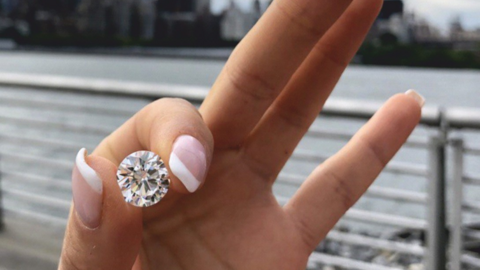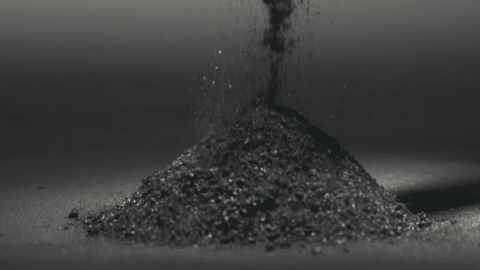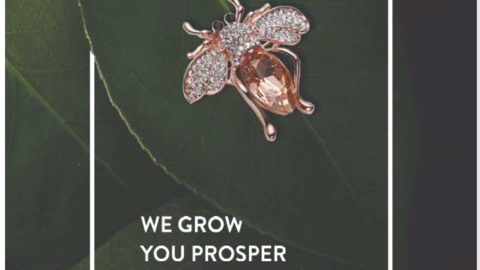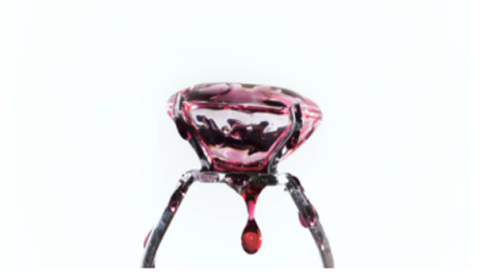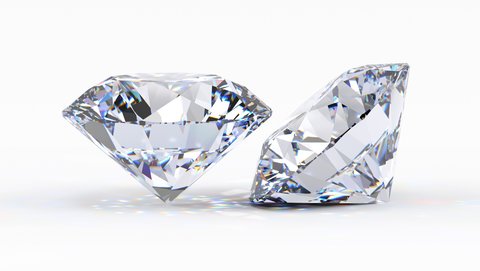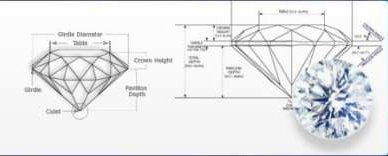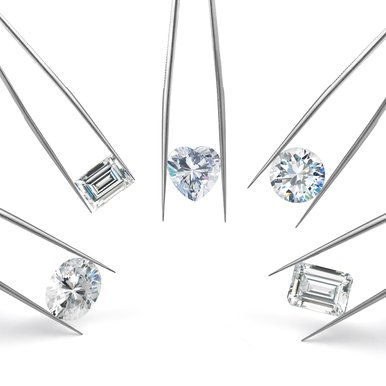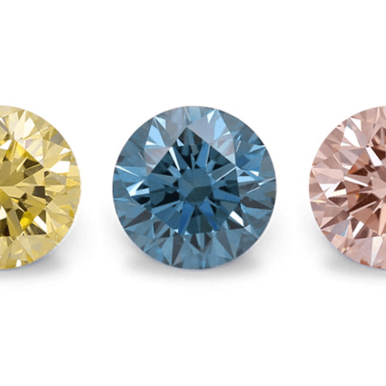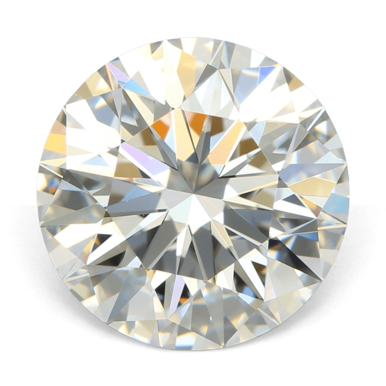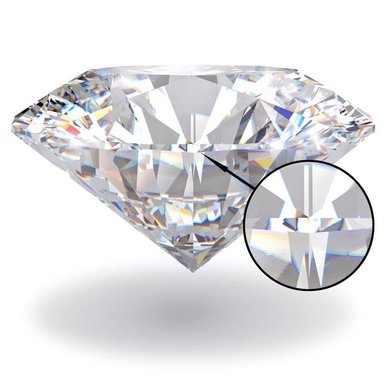Choosing Between Elegance and Brilliance: Emerald vs Radiant Lab-Grown Diamonds

When selecting the perfect lab-grown diamond, the cut plays a crucial role in determining its overall appearance and character. Among the sophisticated options available, emerald and radiant cuts stand out for their distinctive qualities and visual appeal. At Labrilliante, we understand that choosing between these two exquisite cuts requires careful consideration of their unique characteristics. This comprehensive guide will walk you through everything you need to know about emerald and radiant cut lab-grown diamonds to help you make an informed decision that aligns with your style preferences and budget.
At a Glance: Emerald vs Radiant Cut Comparison
Before diving into the specifics, let's examine the key differences between emerald and radiant cut lab-grown diamonds:
Emerald Cut vs Radiant Cut Lab-Grown Diamonds: A Comprehensive Comparison
| Feature | Emerald Cut | Radiant Cut |
|---|---|---|
| Facet Pattern | Step-cut (57 facets) | Brilliant-cut (70 facets) |
| Visual Effect | Elegant "hall of mirrors" | Intense sparkle and fire |
| Shape | Rectangular with cut corners | Rectangular or square with cut corners |
| Ideal L/W Ratio | 1.3-1.6 | 1.0-1.35 |
| Clarity Importance | Higher (inclusions more visible) | Lower (inclusions less visible) |
| Color Importance | Higher (color more visible) | Lower (color less visible) |
| Price Per Carat | Generally lower | Generally higher |
| Best For | Vintage, elegant styles | Modern, brilliant styles |
The primary distinction between these two cuts lies in their faceting styles. While emerald cuts feature step-cut facets that create a sophisticated "hall of mirrors" effect, radiant cuts utilize brilliant-cut faceting to maximize sparkle and fire. This fundamental difference influences nearly every aspect of the diamond's appearance and performance.
The Timeless Elegance of Emerald Cut Lab-Grown Diamonds
Emerald cut diamonds originated during the Art Deco period of the 1920s and 1930s, though the cutting technique dates back to the 16th century when it was initially used for emerald gemstones. This historical cut has maintained its popularity for its distinctive geometric precision and sophisticated appeal.
The emerald cut features 57 facets arranged in a step-cut pattern, creating long, rectangular facets that run parallel to the diamond's edges. Unlike brilliant cuts that focus on maximizing sparkle, the step-cut faceting of emerald diamonds produces a different kind of visual effect—often described as a "hall of mirrors" with its crisp, clean reflections.
Most emerald cut diamonds have a rectangular shape with cut corners and feature an ideal length-to-width ratio between 1.3 and 1.6. At Labrilliante, our master cutters carefully craft each emerald cut lab-grown diamond to achieve optimal proportions that enhance its elegant appearance while maintaining its unique character.
The visual appeal of an emerald cut diamond lies in its clarity and transparency rather than its brilliance. When light enters an emerald cut diamond, it creates broad flashes of light rather than the sparkle associated with brilliant cuts. This understated elegance makes emerald cut lab-grown diamonds particularly appealing to those who appreciate sophisticated, architectural aesthetics.
The Dazzling Brilliance of Radiant Cut Lab-Grown Diamonds
The radiant cut was developed in 1977 by master diamond cutter Henry Grossbard, making it a relatively modern addition to the diamond world. Grossbard's innovative design combined the elegant shape of emerald cut diamonds with the exceptional brilliance of round brilliants, creating a versatile and captivating diamond cut.
A radiant cut diamond features 70 facets in a brilliant-cut pattern, strategically arranged to maximize light return and create impressive sparkle. Unlike the emerald cut's step-cut faceting, the radiant cut's brilliant facet arrangement creates a dynamic play of light with exceptional fire and scintillation from every angle.
Radiant cut lab-grown diamonds at Labrilliante are available in both square and rectangular shapes, always with distinctively cut corners. Square radiants typically have a length-to-width ratio of 1.0-1.05, while rectangular radiants generally range from 1.05 to 1.35. This versatility allows our customers to select the precise proportions that best suit their preferences and intended jewelry setting.
What truly sets the radiant cut apart is its remarkable ability to capture and reflect light. When properly cut by Labrilliante's skilled artisans, a radiant diamond displays an intense sparkle that rivals even that of a round brilliant, while maintaining a sophisticated rectangular or square silhouette that offers greater visual presence per carat.
The Essential Differences: Emerald Cut vs Radiant Cut Lab-Grown Diamonds
When choosing between emerald and radiant cut lab-grown diamonds, understanding their key differences will help you make a decision that best suits your preferences and lifestyle. Let's explore these distinctions in detail:
Brilliance and Light Performance
The most significant difference between emerald and radiant cut diamonds lies in how they interact with light:
Emerald Cut: With its step-cut faceting pattern, an emerald cut diamond produces broad flashes of light and a distinctive "hall of mirrors" effect. The large, open table allows for clear visibility into the diamond, emphasizing transparency over sparkle. This creates a more subtle, sophisticated light display that showcases the diamond's clarity and color.
Radiant Cut: Featuring a brilliant-cut faceting structure, radiant diamonds are designed to maximize light return and sparkle. The 70 carefully arranged facets create exceptional fire (colored light dispersion), brilliance (white light return), and scintillation (sparkle when moved). This results in a dazzling display that catches attention from across the room.
Clarity Considerations
The faceting styles of these two cuts affect how visible inclusions are within the diamond:
Emerald Cut: The step-cut faceting and large, open table of emerald cut diamonds make inclusions more visible to the naked eye. At Labrilliante, we recommend selecting emerald cut lab-grown diamonds with a clarity grade of VS1 or higher to ensure a clean appearance. The advantage of our lab-grown diamonds is that they typically have fewer inclusions than mined diamonds, making them excellent candidates for this revealing cut.
Radiant Cut: The complex brilliant faceting pattern of radiant cut diamonds helps to hide inclusions by dispersing light in multiple directions. This makes radiant cuts more forgiving when it comes to clarity, allowing for selections in the VS2 range while still appearing eye-clean. This can make radiant cut lab-grown diamonds an excellent value proposition at Labrilliante.
Color Visibility
Just as with clarity, the different faceting styles affect how color is perceived in these diamonds:
Emerald Cut: The large, open facets of emerald cut diamonds tend to retain and show color more readily. For the most impressive white appearance, we recommend selecting emerald cut lab-grown diamonds in the G color range or higher at Labrilliante. For those seeking a truly colorless appearance, our D-F color options provide exceptional visual purity.
Radiant Cut: The brilliant faceting of radiant cut diamonds helps to mask slight color tints by breaking up light into smaller reflections. This allows for greater flexibility in color selection, with G color often appearing nearly colorless once set in jewelry. This can provide better value while maintaining excellent visual appeal.
Dimensions and Proportions
The ideal proportions for emerald and radiant cuts differ in ways that affect their overall appearance:
Emerald Cut: The classic emerald cut typically has a length-to-width ratio between 1.3 and 1.6, creating a rectangular silhouette that elongates the finger when worn in a ring. At Labrilliante, we find that a ratio of approximately 1.5:1 tends to be the most popular among our clients, offering an elegant, balanced appearance. The ideal table percentage (the width of the top facet relative to the width of the diamond) for an emerald cut is typically between 60-70%.
Radiant Cut: Radiant cuts offer more flexibility in proportions, ranging from nearly square (1.0-1.05 ratio) to more rectangular shapes (up to 1.35 ratio). Square radiants provide a modern look similar to princess cuts but with cut corners for better durability, while rectangular radiants offer some of the finger-lengthening benefits of emerald cuts while maintaining brilliant-cut sparkle. The ideal table percentage for radiant cuts is typically between 61-69%.
Comparison of Ideal Proportions for Emerald and Radiant Cuts
| Parameter | Emerald Cut | Radiant Cut |
|---|---|---|
| Length-to-Width Ratio | 1.3-1.6 (1.5 most popular) | 1.0-1.35 |
| Table Percentage | 60-70% | 61-69% |
| Depth Percentage | 61-67% | 61-67% |
| Crown Height | 11-13% | 10-14% |
| Pavilion Depth | 42-46% | 40-45% |
| Girdle Thickness | Thin to slightly thick | Thin to medium |
| Culet | None (pointed) or very small | None (pointed) |
Durability Considerations
The structural differences between these cuts affect their long-term durability:
Emerald Cut: The step-cut faceting of emerald cut diamonds creates four pointed corners that, if not protected by proper settings, could be vulnerable to chipping. However, the signature cut corners of the emerald shape help mitigate this risk by eliminating the four most vulnerable points. At Labrilliante, we recommend protective settings like V-prongs or bezel settings to further enhance durability.
Radiant Cut: The brilliant-cut faceting combined with cut corners makes radiant cut diamonds exceptionally durable. The cut corners eliminate vulnerable sharp points, while the faceting pattern distributes force more evenly throughout the stone. This makes radiant cut lab-grown diamonds from Labrilliante an excellent choice for those with active lifestyles or who plan to wear their diamond jewelry daily.
Price Comparison
Price differences between these cuts can be significant:
Emerald Cut: Due to less material waste during the cutting process and lower demand compared to brilliant cuts, emerald cut lab-grown diamonds typically cost 10-15% less per carat than radiant cut diamonds of comparable quality. This makes emerald cuts at Labrilliante an excellent value proposition, offering significant visual presence and sophisticated elegance at a more accessible price point.
Radiant Cut: The complex brilliant-cut faceting of radiant diamonds requires more precision and labor during the cutting process, contributing to their higher price per carat. However, because they hide inclusions and color better than emerald cuts, you can often select lower clarity and color grades while maintaining excellent visual appeal, potentially balancing the overall cost.
Finding Your Perfect Setting: Style Recommendations for Emerald and Radiant Cuts
The right setting can enhance the unique characteristics of your chosen diamond cut while reflecting your personal style. At Labrilliante, we offer a variety of setting options specifically designed to complement both emerald and radiant cut lab-grown diamonds.
Ideal Settings for Emerald Cut Lab-Grown Diamonds
Emerald cut diamonds exude vintage sophistication and architectural elegance that pairs beautifully with these setting styles:
Classic Solitaire Settings: A simple solitaire setting allows the clean lines and elegant proportions of an emerald cut to take center stage. At Labrilliante, our platinum and white gold solitaires with delicate prongs provide secure support while maximizing light entry into the diamond.
Vintage-Inspired Designs: The Art Deco heritage of emerald cuts makes them perfect partners for vintage-style settings. Consider our filigree settings with milgrain details, which enhance the era-specific appeal of this classic cut while providing a romantic, timeless look.
Three-Stone Settings: Emerald cuts shine in three-stone arrangements, where their geometric precision creates beautiful symmetry. Pairing a center emerald cut with smaller emerald cut or baguette side stones creates a cohesive, sophisticated design that emphasizes the diamond's elegant step-cut faceting.
Channel-Set Bands: The clean lines of emerald cuts complement channel-set bands perfectly. At Labrilliante, we offer channel settings with calibrated emerald or baguette diamonds that extend the linear beauty of your center stone along the band.

Stunning Settings for Radiant Cut Lab-Grown Diamonds
Radiant cut diamonds with their brilliant sparkle work beautifully in these contemporary settings:
Halo Settings: A radiant cut diamond surrounded by a halo of smaller diamonds creates a spectacular display of brilliance. Our Labrilliante halo settings maximize the total sparkle and can make the center stone appear up to half a carat larger than its actual size.
Pavé Bands: The brilliant faceting of radiant cuts pairs perfectly with pavé-set diamond bands that continue the sparkle along the finger. Our micropavé settings feature tiny prongs that secure the small diamonds while allowing maximum light reflection.
Modern Tension Settings: For a contemporary statement, our tension settings appear to suspend the radiant cut diamond between two metal bands, showcasing the diamond's brilliance from all angles while creating a bold, architectural look.
Split-Shank Designs: Split-shank settings, where the band divides as it approaches the center stone, add drama and additional sparkle to radiant cut engagement rings, emphasizing the diamond's brilliant-cut faceting.
Making Your Decision: Finding Your Perfect Lab-Grown Diamond Cut
Choosing between emerald and radiant cut lab-grown diamonds ultimately comes down to your personal preferences, lifestyle, and the statement you want your jewelry to make. Consider these factors to help guide your decision:
Personal Style Considerations
Your individual style preferences play a crucial role in determining which cut will bring you the most satisfaction:
Choose Emerald Cut If You Prefer:
- Clean, geometric lines and architectural elegance
- Subtle sophistication that whispers rather than shouts
- Vintage or Art Deco-inspired aesthetics
- A diamond that emphasizes clarity and transparency
- A more understated, refined appearance
Choose Radiant Cut If You Prefer:
- Maximum sparkle and brilliance in every lighting condition
- A more dynamic, eye-catching diamond
- The perfect balance between modern brilliance and classic shape
- Greater flexibility in clarity and color selection
- A diamond that performs well even in dimmer lighting
Lifestyle Factors
Consider how your daily activities might impact your diamond choice:
Emerald Cut Benefits:
- Lower profile that's less likely to snag on clothing or hair
- Fewer facets that require less frequent cleaning to maintain appearance
- Timeless appeal that transcends changing fashion trends
Radiant Cut Benefits:
- Cut corners that provide excellent durability for active lifestyles
- Brilliant faceting that hides small scratches and maintains sparkle even with some dust
- Versatility for seamless transitions from day to evening wear
Budget Considerations
At Labrilliante, we offer exceptional value on all our lab-grown diamonds, but understanding these differences can help you maximize your budget:
Emerald Cut Value Propositions:
- Lower price per carat than radiant cuts of similar quality
- Larger appearance for the same carat weight due to larger table surface area
- Better value in higher color and clarity grades
Radiant Cut Value Propositions:
- Ability to choose lower clarity grades while maintaining eye-clean appearance
- More flexibility in color selection without visible tinting
- Greater brilliance per carat weight

Keeping Your Diamond Brilliant: Care and Maintenance Tips
Proper care ensures your lab-grown diamond maintains its beauty for generations. While both emerald and radiant cuts from Labrilliante are durable and long-lasting, their different faceting patterns require slightly different maintenance approaches.
General Care for All Lab-Grown Diamonds
Regardless of the cut you choose, these fundamental care practices apply to all Labrilliante lab-grown diamonds:
- Clean your diamond regularly using warm water, mild dish soap, and a soft toothbrush
- Schedule professional cleaning and inspection annually
- Remove your diamond jewelry when engaging in rough activities, applying lotions, or using household chemicals
- Store your diamond jewelry separately from other pieces to prevent scratching
Specific Care for Emerald Cut Diamonds
The large, open facets of emerald cut diamonds require special attention:
- Clean more frequently, as oils and dirt are more visible on the large table facet
- Take extra care with the corners, even though they're cut, they can still be more vulnerable than other areas
- Inspect prong settings regularly, as the rectangular shape may put different pressure on prongs than round shapes
- Consider a professional cleaning twice yearly to maintain the "hall of mirrors" effect
Specific Care for Radiant Cut Diamonds
The brilliant faceting of radiant cut diamonds offers some maintenance advantages:
- The complex facet pattern helps hide small scratches and dirt, making them more forgiving between cleanings
- The cut corners provide excellent durability against chips and cracks
- Clean in ultrasonic cleaners only if your setting allows (consult with Labrilliante experts)
- Maximize brilliance by cleaning before special occasions to ensure all facets perform optimally
Professional Maintenance Services
At Labrilliante, we provide comprehensive care services for your lab-grown diamond jewelry:
- Complimentary cleaning with any purchase
- Annual inspection service to check settings and prongs
- Re-polishing services if needed to restore maximum brilliance
- Setting adjustments to maintain security as rings naturally shift over time
Remember that while lab-grown diamonds have the same hardness as mined diamonds (10 on the Mohs scale), they still require proper care to maintain their exceptional beauty for a lifetime.
Finding Your Perfect Lab-Grown Diamond: The Labrilliante Experience
When searching for the ideal emerald or radiant cut lab-grown diamond, choosing the right retailer is just as important as selecting the diamond itself. At Labrilliante, we provide a comprehensive purchasing experience designed to give you confidence in your investment.
The Labrilliante Advantage
As specialists in lab-grown diamonds, we offer several unique benefits:
- Superior Selection: Our extensive inventory includes emerald and radiant cut lab-grown diamonds in various sizes, colors, and clarity grades to suit any preference and budget.
- Ethical Sourcing: All Labrilliante diamonds are created in controlled laboratory environments using advanced technology that eliminates environmental concerns associated with mining while providing identical physical, chemical, and optical properties to mined diamonds.
- Expert Guidance: Our gemologists provide personalized consultations to help you understand the unique qualities of each cut and select the perfect diamond for your needs.
- Competitive Pricing: By eliminating the middlemen in the traditional diamond supply chain, we offer exceptional value on all our lab-grown diamonds, with prices typically 30-40% lower than comparable mined diamonds.

Online Shopping Experience
At Labrilliante, you are able to shop for your perfect diamond via:
Online Experience:
- 360° high-definition videos of each diamond in our inventory
- Detailed certification information including cut proportions, color, and clarity
- Virtual appointments with our experts from the comfort of your home
- Secure shipping with insurance and 30-day return policy
Price Expectations
When shopping for lab-grown diamonds at Labrilliante, here's what you can generally expect in terms of pricing:
- Emerald Cut Lab-Grown Diamonds: Starting from $1,200 for a 1-carat VS2 clarity, G color diamond
- Radiant Cut Lab-Grown Diamonds: Starting from $1,400 for a 1-carat VS2 clarity, G color diamond
Both cuts increase in price with larger carat weights, higher clarity grades, and better color grades. Our transparent pricing policy ensures you understand exactly what factors influence the cost of your selected diamond.
The Perfect Choice: Making Your Diamond Decision with Confidence
Selecting between emerald and radiant cut lab-grown diamonds is a personal journey that reflects your individual style, preferences, and values. At Labrilliante, we believe that understanding the unique characteristics of each cut empowers you to make a choice that will bring you joy for a lifetime.

Emerald cut lab-grown diamonds offer timeless elegance with their clean lines, sophisticated "hall of mirrors" effect, and vintage appeal. Their step-cut faceting showcases exceptional clarity and color, making them perfect for those who appreciate understated luxury and architectural beauty.
Radiant cut lab-grown diamonds deliver spectacular brilliance with their 70 precisely arranged facets, providing maximum sparkle and fire. Their unique combination of rectangular shape and brilliant-cut faceting offers versatility in both appearance and setting options, making them ideal for those seeking both traditional shape and modern performance.
Whichever cut you choose, Labrilliante's lab-grown diamonds provide exceptional quality, ethical sourcing, and outstanding value. Our expert team is ready to guide you through every step of your diamond journey, from selection to setting, ensuring that your final choice perfectly reflects your personal style and story.
Visit our website and get in touch with us today to explore our collection of exquisite emerald and radiant cut lab-grown diamonds and discover the perfect centerpiece for your next meaningful piece of jewelry.
Other diamond shapes
FAQ About Princess and Cushion Cut Diamonds
Emerald cuts feature 57 step-cut facets creating elegant "hall of mirrors" reflections, while radiant cuts have 70 brilliant-cut facets designed for maximum sparkle. Emerald cuts display clean lines and subtle elegance, whereas radiant cuts offer intense brilliance and fire.
Radiant cut diamonds are typically 10-15% more expensive per carat than emerald cuts due to their complex faceting process. However, since emerald cuts reveal inclusions more readily, you may need higher clarity grades, potentially balancing the overall cost.
Yes, emerald cuts produce less sparkle than radiant cuts by design. Instead of the intense brilliance of radiant cuts, emerald cuts create broad flashes of light and a "hall of mirrors" effect, emphasizing elegance and transparency rather than sparkle.
Radiant cuts significantly outperform emerald cuts in dim lighting due to their brilliant faceting, which maximizes light return even in low-light environments. Emerald cuts rely more on direct light to showcase their distinctive flashes and transparency, making them more environment-dependent.
Yes, even untrained observers can easily distinguish between these cuts. Emerald cuts display straight, parallel step-cut facets creating a distinctive "windowing" effect, while radiant cuts show the triangular and kite-shaped facets characteristic of brilliant cuts, visible even at arm's length.
Emerald cuts pair exceptionally well with platinum and white gold, which enhance their icy transparency. Radiant cuts are more versatile, performing beautifully in all metals—yellow gold warms their appearance, while rose gold creates an interesting contrast with their bright sparkle.
Interestingly, emerald cuts are slightly more susceptible to thermal shock than radiant cuts. The large, open facets and step-cut structure can create stress points that, while rare, might make them marginally more vulnerable to extreme temperature fluctuations compared to the more structurally distributed brilliant faceting of radiant cuts.
Radiant cuts tend to maintain their visual impact better over decades because their brilliant faceting hides minor wear marks and scratches. Emerald cuts, with their large, clean facets, may show surface abrasions more readily over time, potentially requiring more frequent professional repolishing to maintain their pristine appearance.


